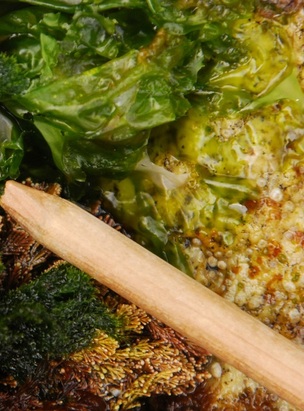Sea cellophane • Monostroma grevillei
{Monostroma = reference to the single cell layer thickness of species in this genus}
 Photo by Joel White
Photo by Joel White
Identification
This green alga has very thin, translucent light green to greenish-yellow blades. The blades are so thin and translucent because they are only a single cell layer (30 µm) thick. The blades are soft, slippery, and delicate. Blade length is generally less than 10cm, and never more than 30cm. The early gametic form of this species is a green thumb-sized sac that can be spotted in tidepools. Mature, gamete-producing blades turn yellowish.
Habitat & Range
Sea cellophane can be found in the mid- and low-intertidal of protected and semi-protected coasts. It can also grow epiphytically on other algae species such as Fucus. Its range stretches along both west and east coastlines of the North Pacific: from Monterey, California north to the Bering Sea and Arctic Ocean; along the Aleutian, Kurile, and Commander Islands, and Kamtschatka; and south along Russia, Japan, and Korea. It is also reported in some coastlines of the North Sea, Baltic Sea, subantarctic islands, and Chile.
Similar Species
Sea cellophane is easily mistaken for Ulva or Kornmania species, but can be distinguished as Ulva grow much thicker (2 cell layers, making them nearly opaque), and Kornmania grow only epiphytically on seagrasses.
iNaturalist
https://www.inaturalist.org/taxa/465247-Monostroma-grevillei
This green alga has very thin, translucent light green to greenish-yellow blades. The blades are so thin and translucent because they are only a single cell layer (30 µm) thick. The blades are soft, slippery, and delicate. Blade length is generally less than 10cm, and never more than 30cm. The early gametic form of this species is a green thumb-sized sac that can be spotted in tidepools. Mature, gamete-producing blades turn yellowish.
Habitat & Range
Sea cellophane can be found in the mid- and low-intertidal of protected and semi-protected coasts. It can also grow epiphytically on other algae species such as Fucus. Its range stretches along both west and east coastlines of the North Pacific: from Monterey, California north to the Bering Sea and Arctic Ocean; along the Aleutian, Kurile, and Commander Islands, and Kamtschatka; and south along Russia, Japan, and Korea. It is also reported in some coastlines of the North Sea, Baltic Sea, subantarctic islands, and Chile.
Similar Species
Sea cellophane is easily mistaken for Ulva or Kornmania species, but can be distinguished as Ulva grow much thicker (2 cell layers, making them nearly opaque), and Kornmania grow only epiphytically on seagrasses.
iNaturalist
https://www.inaturalist.org/taxa/465247-Monostroma-grevillei
References
Guiry, M.D. & Guiry, G.M. (2014). Monostroma grevillei (Thuret) Wittrock. AlgaeBase National University of Ireland, Galway. Accessed 14/11/2014.
Lindberg, M. and Lindstrom, S. (2010). Monostroma grevillei var. grevillei. Seaweeds of Alaska. Accessed 14/11/2014.
O'Clair, R. and Lindstrom, S. Monostroma grevillei (Thuret) Wittrock. In Klinkenberg, Brian. (Ed.). E-Flora BC: Electronic Atlas of the Plants of British Columbia. Lab for Advanced Spatial Analysis, Department of Geography, University of British Columbia, Vancouver. Accessed 14/11/2014.
Authors and editors of page
Joel White, Kelly Fretwell, and Brian Starzomski (2014).
Guiry, M.D. & Guiry, G.M. (2014). Monostroma grevillei (Thuret) Wittrock. AlgaeBase National University of Ireland, Galway. Accessed 14/11/2014.
Lindberg, M. and Lindstrom, S. (2010). Monostroma grevillei var. grevillei. Seaweeds of Alaska. Accessed 14/11/2014.
O'Clair, R. and Lindstrom, S. Monostroma grevillei (Thuret) Wittrock. In Klinkenberg, Brian. (Ed.). E-Flora BC: Electronic Atlas of the Plants of British Columbia. Lab for Advanced Spatial Analysis, Department of Geography, University of British Columbia, Vancouver. Accessed 14/11/2014.
Authors and editors of page
Joel White, Kelly Fretwell, and Brian Starzomski (2014).




